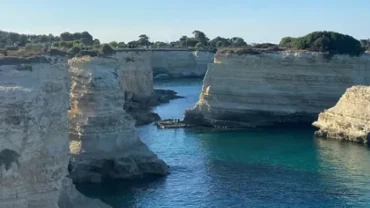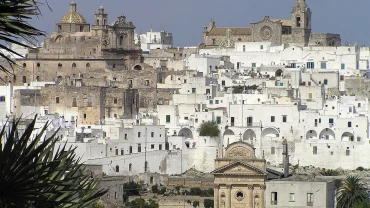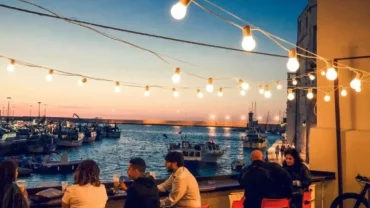Polignano a Mare is one of the most spectacular and popular locations on the Apulian coast.
Perched on the edge of a high cliff rising from the Adriatic Sea, Polignano a Mare is one of the most spectacular and popular locations on the Apulian coast. The historic center of this seaside village is a maze of narrow streets that slope toward a tiny beach, the Lama Monachile, which bisects the cliff. Below the settlement, a tangle of caves invites you to discover a crystal-clear sea.
Polignano is also the hometown of Domenico Modugno, the author of Nel blu dipinto di blu, the most famous Italian song in the world. The historic core of Polignano a Mare, a center inhabited since Neolithic times, is an expanse of white houses of medieval origin clustered on the cliff. The village is entered by passing under the sixteenth-century Marchesale Arch, also known as Porta Grande, which until 1780 was the only point of access to the village that was surrounded by a moat, now hidden by Piazza Garibaldi, with its drawbridge.
Through the narrow streets of Polignano you can get lost, so sooner or later you will come out at an overlook to the sea and the surprise effect will be even greater.
You will undoubtedly find the 13th-century Matrix Church, the Marchesale Palace, home of the feudal lords, the Clock Palace and the 4 defensive towers. The most photographed place in Polignano a Mare is its turquoise-water beach, Lama Monachile, always very crowded of the summer months: the bridge behind it is built over a Roman bridge of the Via Traiana, the Rome-Brindisi of antiquity, which passed right through here. Next door, on the waterfront, you will see a statue dedicated to the world’s most famous Polignanese, singer Domenico Modugno.
On the opposite side of town, again with a spectacular sea view, is the fine museum of the Pino Pascali Foundation, an artist originally from Polignano who died in the 1960s, which displays contemporary art exhibitions.
The atmosphere of Polignano a Mare can be savored as you stroll along the cliff and down to the shoreline from which the view of the white city is spectacular. Forty minutes on foot in the direction of Nola, between the delightful bays of Ponte dei Lapilli and Porto Cavallo, both ideal for swimming, you arrive at the village of San Vito, unmistakable for the presence of the remains of the abbey of the same name, which dates back to the 9th century, to the time of the Basilian monks who took refuge in these lands as they fled the iconoclastic struggles of the Byzantine Empire.
A little further on is the quadrangular tower of St. Vitus in front of a stretch of sea that looks like a natural swimming pool. By day as well as by night, in this idyllic place also full of clubs and restaurants, you will never be alone: Polignano’s movida reaches here. There are about 20 caves that the sea has created with the force of its waves on the cliff on which Polignano stands: the largest is the Palazzese cave, so called because it is located under a noble palace from which it could be accessed. Today the palace has been transformed into a 5-star hotel that in the natural ravines of the cliff has created restaurant rooms, and the cave remains accessible by sea.
Other caves have the most unthinkable names, mostly related to their use over time: the Archbishop’s Cave would have been connected through tunnels to the bishop’s palace, the Nuns’ Cave was used by the nuns of the hospital. The most striking is the Ardito, named after its owners, which inside has a natural column on which fishermen used to climb to the village. On one of the many terraces overlooking the reef, in Polignano’s many restaurants, you can enjoy year-round dishes of seafood crudités, a mixture of cuttlefish, shrimp, scampi, and many other fish depending on the season and catch. For those who prefer their fish well cooked, then the dish to try is rice, potatoes and mussels.
Another local specialty is the very sweet Polignano carrot, grown right in the area of San Vito Abbey and recognized as a Slow Food Presidium. If you prefer street food so you don’t miss a minute of the beach, then try the fish sandwich, with tuna tartare, burrata and tomatoes, or fried octopus and turnip greens, a real treat.
At the end of the meal, indulge in the Caffè Speciale, according to a recipe perfected right here in Polignano: it is a sweetened coffee with added lemon zest, cream and amaretto, served strictly in a small glass.






Comment (0)